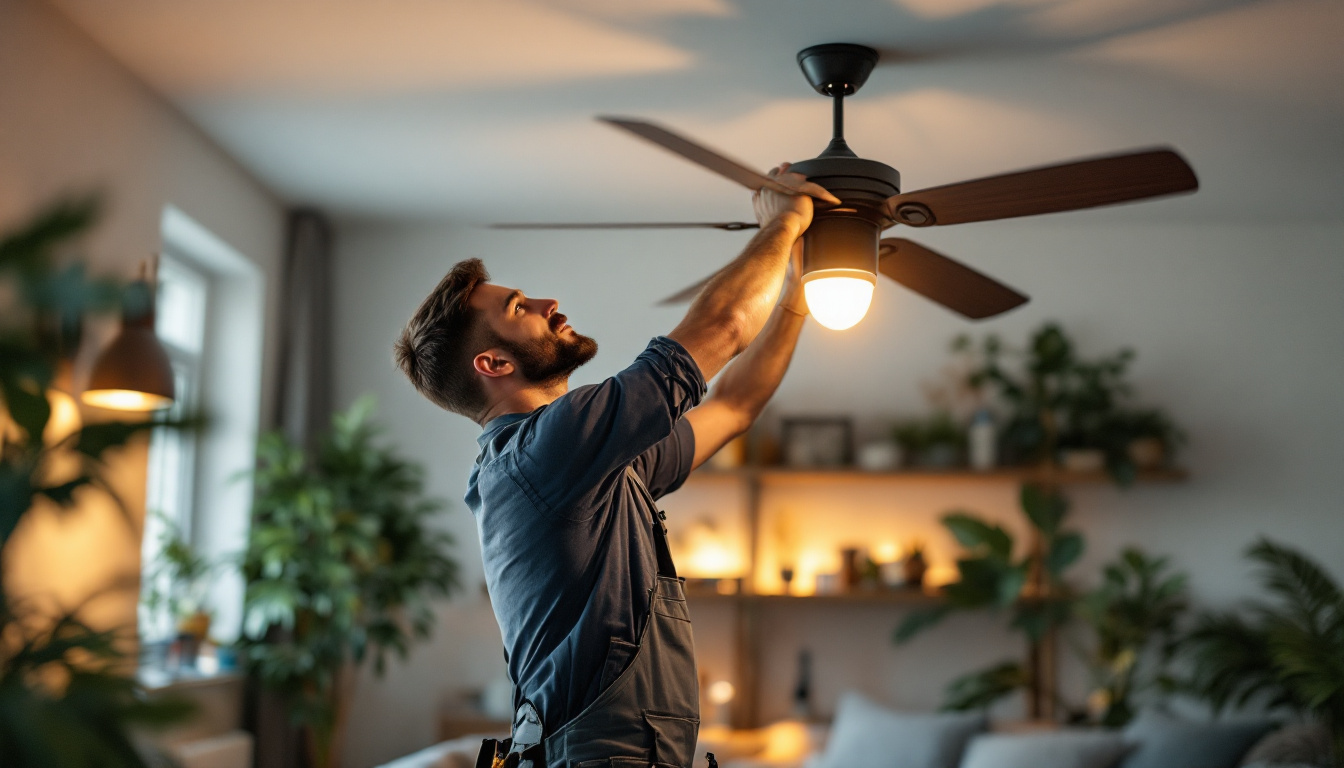
In the realm of lighting design and installation, ceiling fans often play a crucial yet understated role. They are not merely functional devices; they can enhance the aesthetic appeal of a space while providing comfort and energy efficiency. For lighting contractors, understanding the nuances of ceiling fans is essential for delivering comprehensive solutions to clients. This guide aims to equip lighting contractors with the necessary knowledge and insights regarding ceiling fans, focusing on selection, installation, and maintenance.
Ceiling fans come in various types, each designed to meet specific needs and preferences. The most common types include standard ceiling fans, flush mount fans, and outdoor ceiling fans. Standard ceiling fans are versatile and suitable for most indoor spaces, while flush mount fans are ideal for rooms with low ceilings. Outdoor ceiling fans, designed to withstand the elements, are perfect for patios and porches. These fans often feature weather-resistant materials and finishes to prevent rust and corrosion, ensuring durability and longevity in outdoor settings.
Additionally, there are specialty fans, such as dual-motor fans and ceiling fan lights, which combine the functionality of lighting and air circulation. Dual-motor fans allow for independent control of two separate fan units, providing customized airflow in larger spaces. Ceiling fan lights not only enhance the aesthetic appeal of a room but also serve a practical purpose by illuminating the area. Understanding these types allows lighting contractors to recommend the most appropriate fan for each client’s unique requirements, ensuring optimal comfort and style.
When selecting ceiling fans, several features should be taken into account. Blade size and pitch, for instance, significantly affect airflow and efficiency. Larger blades typically move more air, making them suitable for larger rooms. The pitch, or angle of the blades, also influences performance; a pitch of 12 to 15 degrees is generally considered optimal. Fans with adjustable blade pitches can offer versatility, allowing users to customize airflow based on seasonal needs or personal comfort preferences.
Another important feature is the motor type. Ceiling fans can be equipped with either AC or DC motors. While AC motors are common and cost-effective, DC motors are quieter, more energy-efficient, and often come with additional speed settings. These factors should be discussed with clients to help them make informed decisions. Furthermore, many modern ceiling fans now come with smart technology integration, allowing users to control their fans via smartphone apps or voice commands, adding an extra layer of convenience and energy management. This technological advancement is particularly appealing to homeowners looking to enhance their smart home systems while maximizing comfort and efficiency in their living spaces.
Proper installation is key to maximizing the performance and lifespan of a ceiling fan. Before installation, it is essential to assess the location where the fan will be mounted. Factors such as ceiling height, room size, and proximity to light fixtures or other obstructions must be considered. A ceiling fan should ideally be installed at least 7 to 9 feet above the floor for optimal airflow. This height not only enhances the effectiveness of the fan but also ensures that it operates safely without posing a risk to individuals walking underneath it.
Contractors should also ensure that the electrical box is rated for ceiling fan support. This is crucial, as ceiling fans can be heavier than standard light fixtures. Using a fan-rated box will prevent potential hazards and ensure a secure installation. Additionally, it is advisable to check the wiring in the ceiling to confirm that it can handle the electrical load of the fan. If the existing wiring appears frayed or outdated, it may be necessary to upgrade it to ensure safety and compliance with local building codes.
The installation process typically involves several steps. First, the power should be turned off at the circuit breaker to ensure safety. Next, the mounting bracket is attached to the ceiling, followed by the assembly of the fan itself. The blades are then attached, and finally, the light kit, if applicable, is installed. During this assembly, it’s beneficial to have a second person assist, especially when lifting the heavier components, to avoid strain or accidental drops.
It is important to follow the manufacturer’s instructions throughout the process, as each fan may have specific requirements. After installation, testing the fan for proper operation and ensuring that all connections are secure is essential before leaving the site. Additionally, checking for any wobbling during operation is crucial; if the fan wobbles, it may indicate that the blades are not balanced or that the installation was not executed correctly. Balancing kits are often included with ceiling fans and can be used to adjust the blades for smooth operation. Regular maintenance, such as dusting the blades and checking the tightness of screws, will also help in prolonging the fan’s lifespan and maintaining its efficiency.
To ensure longevity and optimal performance, regular maintenance of ceiling fans is necessary. Dust and debris can accumulate on the blades, leading to reduced efficiency and potential noise issues. Contractors should recommend that clients clean the blades regularly, using a soft cloth or a vacuum with a brush attachment.
Additionally, checking the fan’s balance is crucial. An unbalanced fan can wobble, causing noise and wear on the motor. If wobbling occurs, it may be necessary to adjust the blade alignment or use balancing kits that come with many ceiling fans.
Even with proper maintenance, issues may arise. Common problems include the fan not turning on, making unusual noises, or wobbling. If a fan does not turn on, it may be due to a blown fuse, tripped circuit breaker, or faulty wiring. Contractors should be prepared to troubleshoot these issues or guide clients on how to address them.
For noise issues, checking the tightness of screws and ensuring that the blades are properly aligned can often resolve the problem. If wobbling persists, a balancing kit may be necessary to correct the issue.
As energy efficiency becomes increasingly important, many manufacturers now offer ceiling fans designed with energy-saving features. These fans often utilize DC motors, which consume significantly less energy than traditional AC motors. Additionally, energy-efficient models may include LED lighting options that further reduce electricity consumption.
Contractors should be aware of the Energy Star rating, which indicates that a ceiling fan meets strict energy efficiency guidelines. Recommending Energy Star-rated fans can help clients save on their energy bills while also contributing to environmental sustainability.
Educating clients on the proper use of ceiling fans can also enhance energy efficiency. For example, during the summer months, fans should be set to rotate counterclockwise to create a cooling breeze, while in the winter, they should rotate clockwise to circulate warm air. Encouraging clients to utilize these settings can lead to increased comfort and reduced reliance on heating and cooling systems.
In residential settings, ceiling fans can be used in various rooms, including living rooms, bedrooms, and kitchens. In living rooms, larger fans with decorative designs can serve as focal points while providing comfort. In bedrooms, quieter models with dimmable lighting options are often preferred to create a relaxing atmosphere.
In kitchens, ceiling fans should be chosen with care due to the presence of heat and humidity. Outdoor-rated fans can also be installed in covered patios or sunrooms to enhance airflow and comfort during warm months.
In commercial settings, ceiling fans can significantly enhance the comfort of employees and customers alike. larger industrial ceiling fans are often used in warehouses and retail spaces to improve air circulation. These fans can help reduce energy costs by allowing HVAC systems to operate more efficiently.
For restaurants and cafes, stylish ceiling fans can contribute to the overall ambiance while ensuring a comfortable environment for patrons. Selecting fans that complement the decor can enhance the customer experience.
Ceiling fan design has evolved significantly, with many modern fans featuring sleek lines and minimalist aesthetics. These designs often incorporate materials such as wood, metal, and glass, allowing them to blend seamlessly into contemporary interiors. Lighting contractors should stay informed about current design trends to provide clients with stylish options that suit their tastes.
Smart ceiling fans have also gained popularity, featuring integrated technology that allows users to control the fan via smartphone apps or voice commands. This trend aligns with the growing demand for smart home solutions, making it an attractive option for tech-savvy clients.
Color and finish choices have expanded, allowing for greater customization. Fans are available in a range of colors, from classic white and black to bold hues that can serve as statement pieces. Finishes such as brushed nickel, oil-rubbed bronze, and distressed wood offer additional options for matching fans to existing decor.
Lighting contractors should encourage clients to consider these options when selecting a ceiling fan, as the right color and finish can enhance the overall aesthetic of a space.
Ceiling fans are an integral part of lighting and comfort solutions in both residential and commercial spaces. By understanding the various types, installation guidelines, maintenance practices, and design trends, lighting contractors can provide valuable recommendations to clients. As energy efficiency and smart technology continue to shape the industry, staying informed will ensure that contractors remain competitive and capable of meeting diverse client needs.
Ultimately, the right ceiling fan can enhance the functionality and aesthetic appeal of a space, making it a worthwhile investment for clients. By leveraging this guide, lighting contractors can navigate the world of ceiling fans with confidence, ensuring that they deliver exceptional service and solutions.
Ready to elevate your lighting projects with the finest ceiling fans on the market? Look no further than LumenWholesale, where we offer an exceptional range of spec-grade ceiling fans at unbeatable wholesale prices. Say goodbye to local distributor markups and hello to top-quality products that meet the highest industry standards. With our commitment to affordability and convenience, you’ll enjoy free shipping on bulk orders, ensuring you get the best value without any hidden costs. Enhance your lighting solutions today by visiting Wholesale Lighting at the Best Value and discover how we can help you achieve the perfect balance of style, performance, and price.

Discover the must-have 4-foot fluorescent tube lights that every lighting contractor needs in their toolkit.

Discover how 6-inch LED recessed lighting can be a game-changer for lighting contractors.

Discover expert techniques and proven methods for installing single pole light switches, tailored specifically for lighting contractors.

Discover how lighting contractors are transforming spaces with Flood Light LED technology.